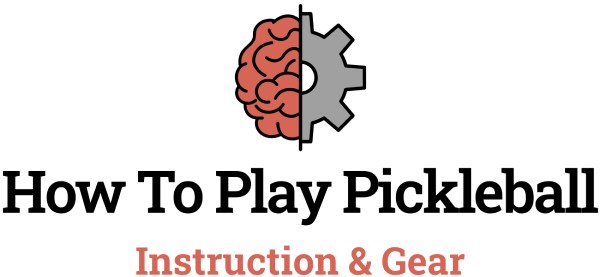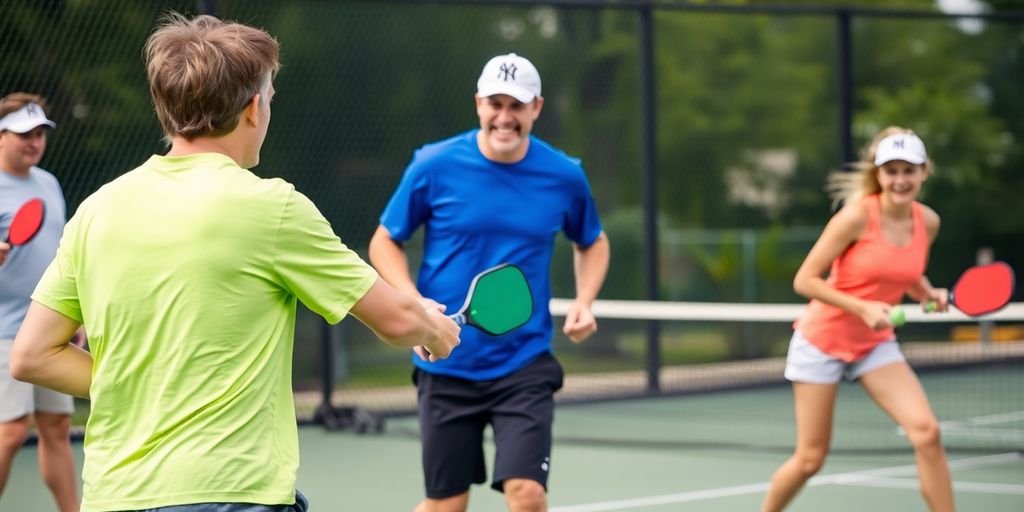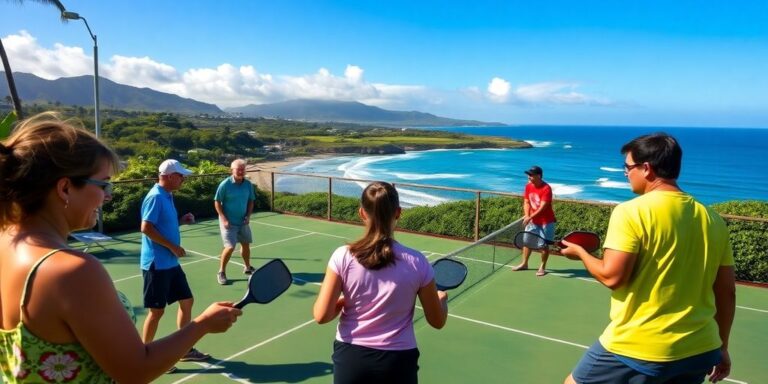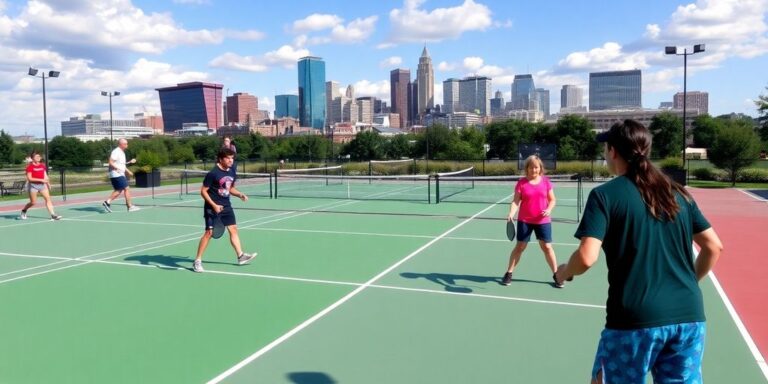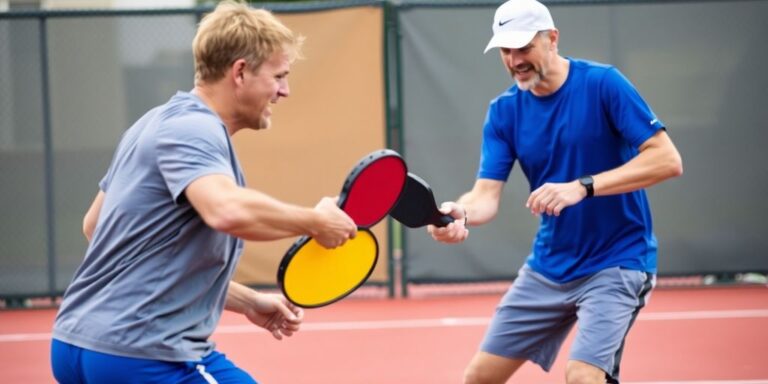So, you want to get good at pickleball, huh? Whether you’re just starting out or you’ve been playing for a while, understanding the rules is key. Pickleball might seem simple at first, but there’s a lot to it. From knowing the court layout to mastering the scoring system, every detail matters. Let’s break down the essentials and even dive into some advanced strategies to up your game.
Key Takeaways
- Pickleball rules are crucial for both beginners and experienced players to ensure fair play.
- Understanding the court dimensions and equipment can enhance your gameplay.
- The scoring system might seem tricky at first, but practice makes it second nature.
- Mastering the non-volley zone is essential for advanced play.
- Good sportsmanship and etiquette make the game enjoyable for everyone.
Understanding the Basics of Pickleball Rules
The Court and Equipment Essentials
Pickleball is played on a court similar to a badminton court, with dimensions of 20 feet by 44 feet. The net is hung at 36 inches at the sidelines and 34 inches in the middle. It’s crucial to have the right equipment to enjoy the game fully. You’ll need a paddle, which is smaller than a tennis racket but larger than a ping-pong paddle, and a plastic ball with holes, often referred to as a wiffle ball.
Here’s a quick checklist of what you’ll need:
- A pickleball paddle
- A pickleball (plastic ball with holes)
- Appropriate athletic wear and shoes
Scoring System Explained
The scoring in pickleball can be a bit tricky for beginners. Games are typically played to 11 points, and you must win by 2 points. Only the serving team can score points. A match is usually best two out of three games.
Here’s a simple breakdown:
- Points are scored only by the serving team.
- A game is played to 11 points, win by 2.
- Matches are best of three games.
Basic Gameplay and Serving Rules
In pickleball, the serve is made underhand and must be hit below the waist. The server must stand behind the baseline and serve diagonally to the opponent’s service court. A unique rule in pickleball is the "double bounce rule," which requires that the ball must bounce once on each side before players can volley.
Key points to remember:
- Serve underhand and below the waist.
- Serve diagonally across the court.
- Follow the double bounce rule: ball must bounce once on each side before volleying.
Understanding these basic rules and equipment needs is the first step in enjoying pickleball, a sport that’s accessible and fun for all ages. Whether you’re playing for leisure or gearing up for competitive play, these essentials will ensure you’re ready to hit the court.
Advanced Pickleball Strategies for Competitive Play
Mastering the Non-Volley Zone
The non-volley zone, often called the "kitchen," is a critical part of the pickleball court. Mastering this area can significantly improve your game. Here are some tips:
- Stay light on your feet to quickly move in and out of the zone.
- Practice dinking, a soft shot that lands just over the net, to control the pace of the game.
- Use the non-volley zone to force opponents to make mistakes by keeping the ball low.
Effective Communication with Your Partner
In doubles, communication is key to success. Here’s how to keep things running smoothly:
- Call out shots as soon as you know who should take them.
- Develop signals or code words for specific plays or strategies.
- Always encourage each other, even after a missed shot, to maintain morale.
Playing doubles is all about teamwork. When you and your partner are in sync, it feels like you’re unstoppable on the court.
Developing a Winning Game Plan
Creating a strategy before you play can give you a significant edge. Consider these elements:
- Assess your opponent’s weaknesses during warm-ups and plan to exploit them.
- Mix up your shots to keep your opponents guessing, alternating between hard drives and soft dinks.
- Always have a backup plan in case your initial strategy isn’t working.
Remember, the best players are those who can adapt quickly and effectively to changing circumstances on the court. By focusing on these strategies, you’ll be well on your way to becoming a formidable player in any competitive setting.
Physical Conditioning for Pickleball Players
Cardiovascular Fitness and Agility
To excel in pickleball, you need a good mix of speed and endurance. A solid cardio routine can make a huge difference on the court. Start with activities that get your heart pumping, like jogging, cycling, or jumping rope. Aim for at least 150 minutes of moderate aerobic exercise a week. Agility drills are also key; think ladder drills or cone drills to improve footwork and reaction time. These exercises help you move quickly and efficiently, essential for reaching those tricky shots.
Strength and Flexibility Training
Building muscle strength is not just for bodybuilders. In pickleball, it helps with power in your shots and stability in your stance. Focus on exercises like squats, lunges, and push-ups. Don’t forget your core—planks and Russian twists can really help. Flexibility is just as important; it keeps you limber and less prone to injuries. Incorporate stretching routines or yoga into your weekly schedule to maintain a full range of motion.
Injury Prevention Techniques
Nobody wants to be sidelined by an injury, so it’s crucial to take steps to prevent them. Start with a proper warm-up before your games—light jogging and dynamic stretches are great. Pay attention to your footwear; shoes with good support can prevent ankle twists. Also, listen to your body. If something feels off, don’t push through the pain. Rest when you need to and consider consulting a physical therapist for persistent issues.
Mental Toughness and Focus in Pickleball

Developing a Winning Mindset
In pickleball, having the right mindset can make all the difference. It’s not just about physical skills; mental strength is crucial. Start by setting clear goals for each match or practice session. This helps maintain focus and gives you something to strive for. Visualization is another powerful tool. Before stepping on the court, take a moment to picture yourself executing perfect shots and strategies. This mental rehearsal can boost your confidence and performance.
Staying Composed Under Pressure
Pressure situations are inevitable in pickleball, whether it’s a close match or dealing with a tough opponent. The key is to stay calm and composed. Here are a few tips:
- Breathe Deeply: When tension rises, take a few deep breaths to center yourself.
- Positive Self-Talk: Replace negative thoughts with encouraging words.
- Focus on the Present: Concentrate on the current point, not past mistakes or future worries.
By practicing these techniques, you can handle pressure more effectively and maintain your performance levels.
Visualization and Mental Rehearsal
Visualization isn’t just for elite athletes; it’s a tool anyone can use to improve their game. Spend a few minutes each day imagining yourself playing your best pickleball. Focus on your form, the sound of the paddle hitting the ball, and the feeling of success. This mental practice can help solidify your skills and prepare you for real-game situations.
Building mental toughness is like strengthening a muscle; it takes consistent effort and practice. But once developed, it can be the edge you need to excel in competitive matches.
Pickleball Etiquette and Sportsmanship
Respecting Opponents and Officials
In pickleball, showing respect to your opponents and officials is as important as mastering your serve. Always acknowledge your opponent’s good shots with a nod or a simple "nice shot". This small gesture fosters a positive atmosphere on the court. When it comes to officials, questioning calls respectfully, and accepting their decisions gracefully, even if you disagree, is crucial. Remember, they’re human too and can make mistakes.
Proper Court Conduct
Maintaining proper court conduct ensures everyone enjoys the game. Here are some key points to keep in mind:
- Wait your turn: Be patient and wait for your turn to play, especially on challenge courts.
- Call the score clearly: This avoids confusion and keeps the game flowing smoothly.
- Stay on your side: Avoid crossing into your opponent’s area unless absolutely necessary.
Handling Disputes Gracefully
Disagreements are bound to happen, but handling them gracefully is what sets great players apart. If a dispute arises, take a moment to breathe and calmly discuss the issue with your opponent. If necessary, involve an official to mediate. The goal is to resolve the issue without letting emotions take over. Ultimately, pickleball is about having fun and enjoying the game, not letting arguments spoil the experience.
Pickleball isn’t just about winning; it’s about promoting confidence and respect while playing. Keeping a cool head and a respectful demeanor can turn a tense match into a memorable one.
Choosing the Right Pickleball Gear

Selecting the Perfect Paddle
When it comes to picking a paddle, comfort and control are key. For beginners, paddles made from fiberglass offer a nice balance of power and control. The GoSports GS1 paddle is a fantastic option for those just starting out, thanks to its great pop and easy handling. Take your time to test different paddles to find one that feels right in your hand.
Apparel and Footwear for Optimal Performance
Wearing the right clothes can make a big difference on the court. Opt for breathable, moisture-wicking fabrics to keep you cool. As for shoes, look for tennis shoes with a solid grip to prevent slipping. Comfort is crucial, so make sure your footwear provides ample support for those quick moves.
Understanding Ball Types and Their Uses
Balls come in different types depending on where you play. Indoor balls are softer and have larger holes, while outdoor balls are harder with smaller holes. Pick a durable ball that suits your playing environment to ensure a consistent game. Having the right ball can really enhance your playing experience.
Building a Thriving Pickleball Community
Finding Local Clubs and Partners
Getting involved in your local pickleball scene is a great way to meet new friends and improve your game. Start by searching for nearby clubs or community centers that offer pickleball sessions. Many places host "open play" times where anyone can join, making it easy to connect with other enthusiasts. Networking with local players not only enhances your skills but also enriches your social life.
Organizing Pickleball Events
Hosting events like tournaments and social gatherings can really boost community spirit. Begin with small, friendly matches and gradually scale up to larger tournaments. Consider organizing skill-building clinics where players can learn from more experienced members. This not only improves skills but also strengthens community bonds.
Contributing to a Positive Community Atmosphere
A welcoming environment is key to a thriving community. Encourage sportsmanship and inclusivity by celebrating everyone’s achievements, big or small. Create a space where feedback is constructive and everyone feels valued.
Building a supportive pickleball community is about more than just playing the game; it’s about creating lasting friendships and a sense of belonging.
Whether you’re hosting events or just participating, your positive attitude can inspire others and help the community grow. Remember, the goal is to enjoy the game and the camaraderie it brings.
Join us in creating a vibrant pickleball community where everyone can learn and grow together! At Nunnery’s Pickleball Lab, we offer exciting resources, live Q&A sessions, and expert advice to help you improve your game. Don’t miss out on the fun—visit our website to get started today!
Wrapping It Up: Your Pickleball Journey Awaits
So there you have it, folks! Whether you’re just starting out or looking to sharpen your skills, pickleball is a game that welcomes everyone. It’s not just about the rules or the techniques; it’s about the fun, the community, and the thrill of the game. Remember, every pro was once a beginner, so don’t sweat the small stuff. Grab your paddle, hit the court, and enjoy every moment. Who knows? You might just find your new favorite hobby. Happy playing!
Frequently Asked Questions
What is pickleball?
Pickleball is a paddle sport that combines elements of tennis, badminton, and ping-pong. It’s played on a court with a net, using paddles and a plastic ball with holes.
How do you score points in pickleball?
Points are scored only by the serving team. A team scores a point when the opposing team fails to return the ball, hits it out of bounds, or commits a fault.
What equipment do I need to play pickleball?
To play pickleball, you’ll need a paddle, a pickleball (a plastic ball with holes), and a court with a net. Comfortable sportswear and proper court shoes are also recommended.
How is pickleball different from tennis?
Pickleball is played on a smaller court with a lower net, using paddles instead of rackets and a plastic ball instead of a tennis ball. The rules and scoring are also different.
Can pickleball be played indoors?
Yes, pickleball can be played indoors or outdoors. Indoor pickleball typically uses a slightly different ball designed to have less bounce.
Is pickleball easy to learn for beginners?
Yes, pickleball is known for being easy to learn and fun for players of all ages and skill levels. Its simple rules and smaller court make it accessible for beginners.
